Creative Rhythm Guitar
In today’s rhythm guitar lesson, I am going to show you five different ways to play a four-chord progression. I will take you through a pop, rock, funk, jazz and reggae pattern and show you how to incorporate new rhythms into your own guitar playing. Make sure you watch the video before playing through the examples, so you can see and hear the examples at full and slow speeds.
Creative Rhythm Guitar Example 1 – Chord Progression
The chord sequence that I have based this entire article on is C#m, A, B(sus) and G#m. Shown below is this chord progression written as barre chords.

Creative Rhythm Guitar Example 2 – Pop Pattern
To make things more exciting than just using plain barre chords example two introduces some open strings. This pattern is very common in pop and acoustic guitar, and the open strings create a ringing sound to the chords.
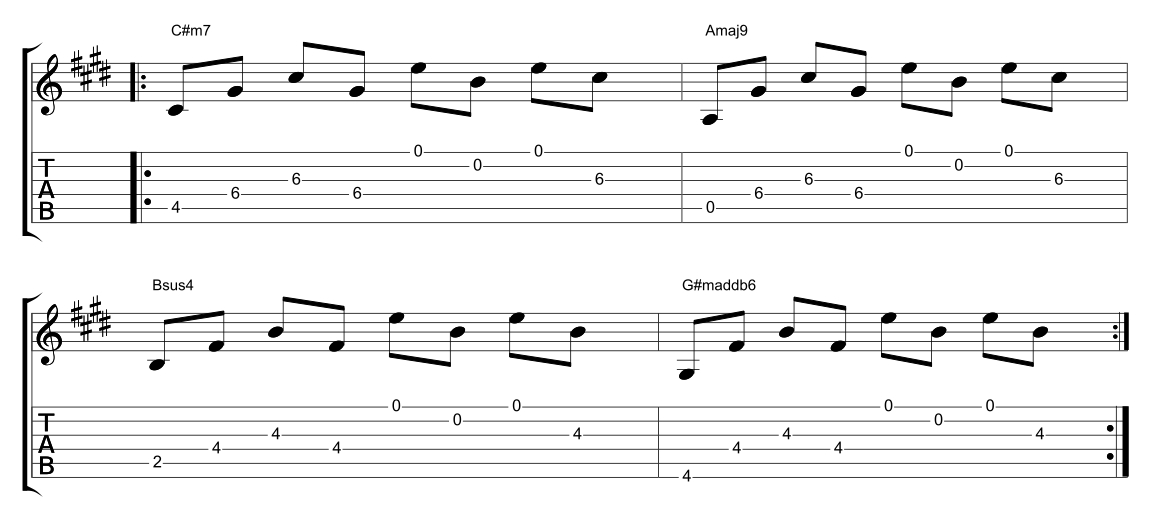
Creative Rhythm Guitar Example 3 – Rock Pattern
Andy Summers loved to use add9 power chords to add variety to his rhythm playing. A famous example of this chord would be the track Message In A Bottle. Example three uses the same starting chord to Message In A Bottle but then moves the chord shape to fit our chord progression. At the end of bar four, I added a mini C#m Pentatonic (C#E F# G# B) lick to complete this pattern.
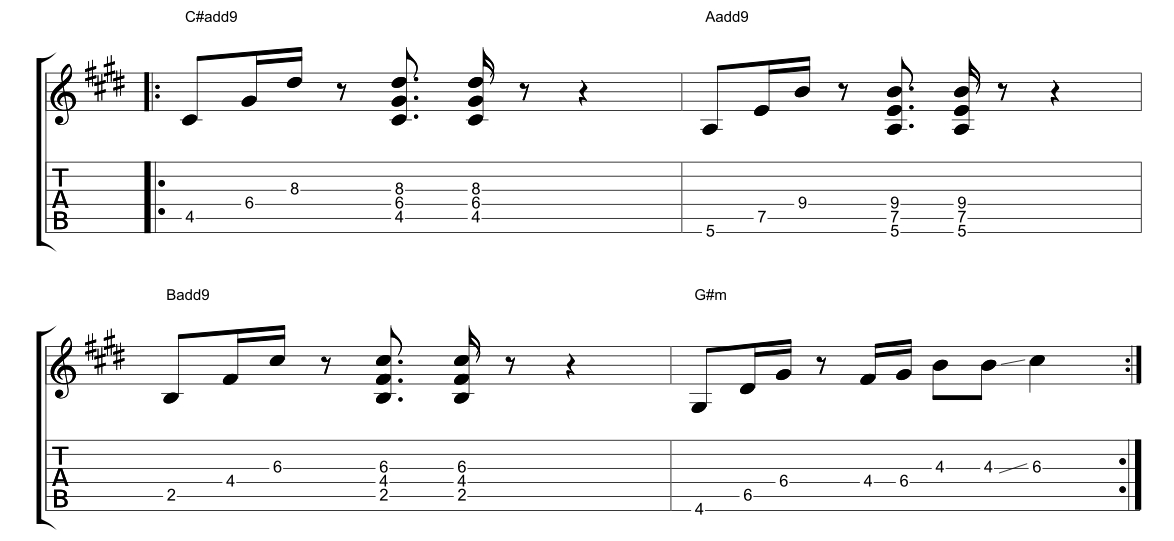
Creative Rhythm Guitar Example 4 – Funk Pattern
Example four demonstrates some of the core elements used in Funk guitar. By adding in hammer-ons to the C#m7 chord seen in bar one, we instantly create a funky sound (think of the introduction to the funk classic Long Train Runnin’ by the Doobie Brothers). Concentrate on keeping your strumming hand playing consistent 1/16th notes throughout this example and watch the slowed down version of the video before speeding it up.
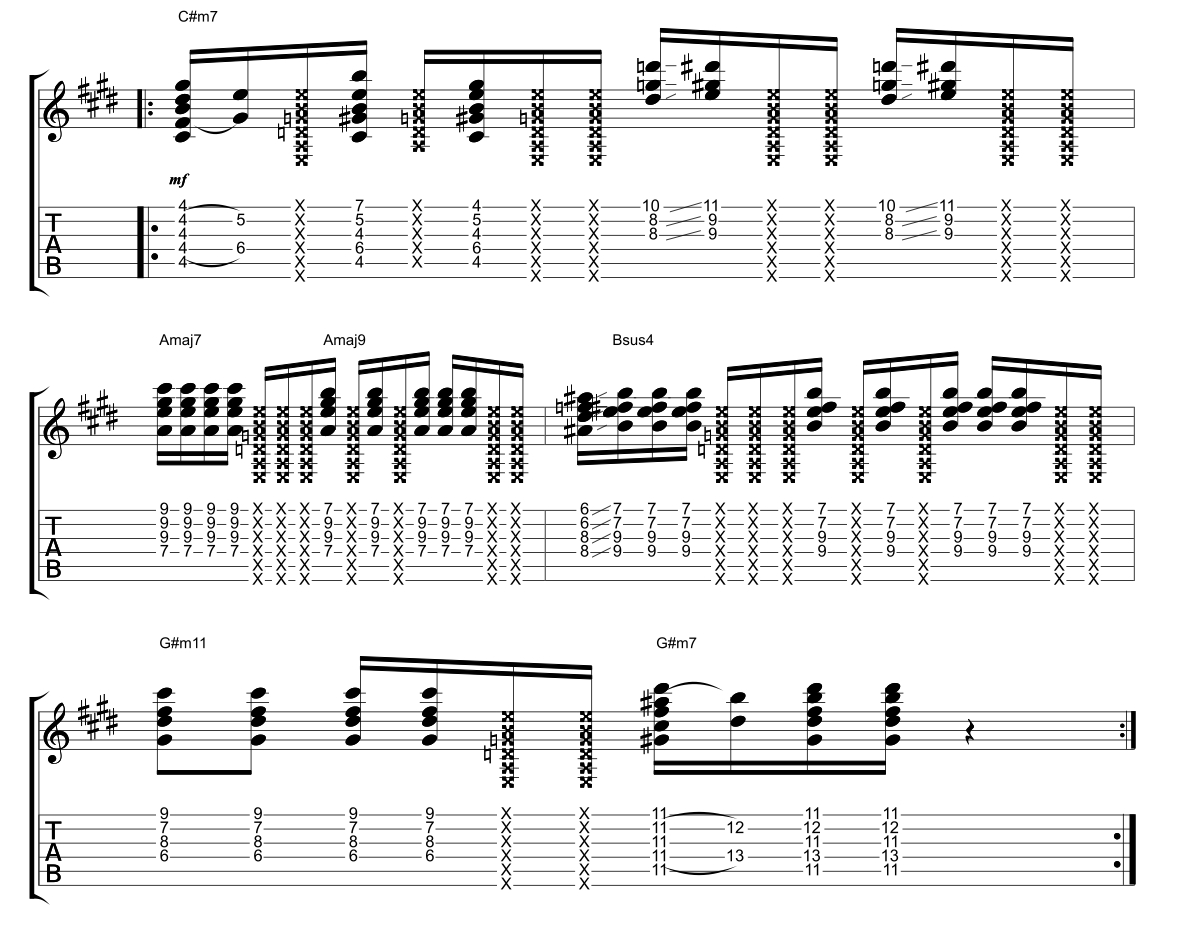
Creative Rhythm Guitar Example 5 – Jazz Pattern
In example 5 I have used some jazzier chord voicings to make a more sophisticated sounding pattern. The minor 9 chord seen in bar one can take time to fret confidently, but it is well worth the effort. Start off slowly and try fingerpicking this example instead of using a pick.
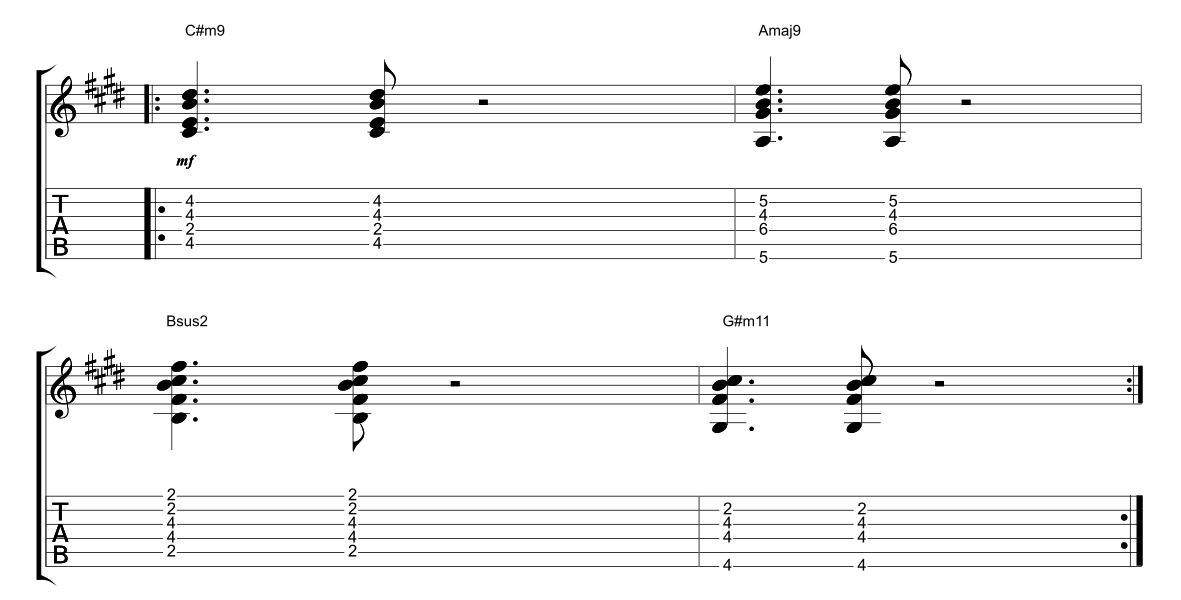
Creative Rhythm Guitar Example 6 – Reggae Pattern
Triads (three note chords) are an excellent way to make your rhythm guitar parts stand out, either in a band or recording scenario. By playing on the +’s (ands) of each beat, we can create an off-beat rhythm pattern which is synonymous with reggae and ska guitar parts. In the slowed down version I fretted the full chord that each of these triads came from so you can see the triads in context.
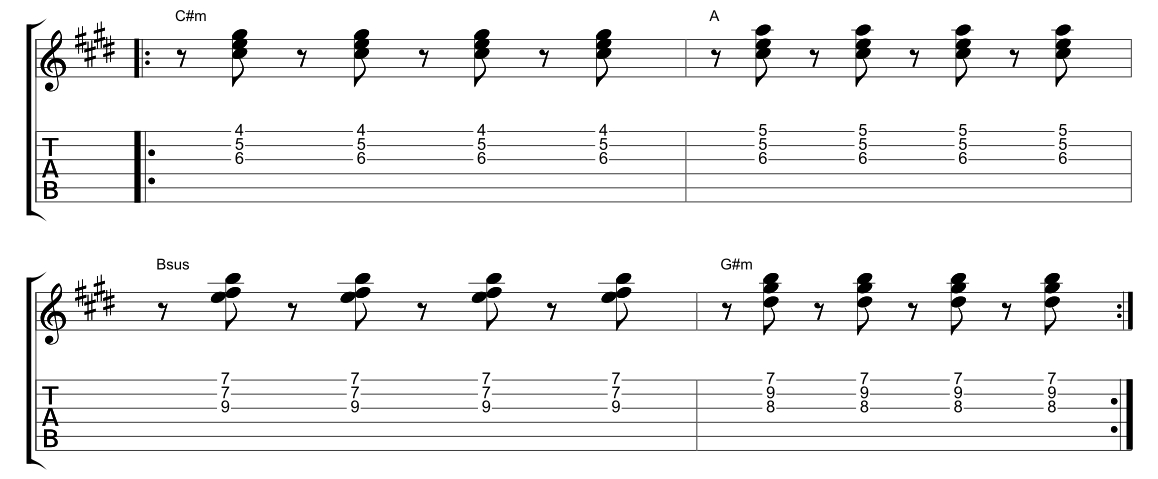
Recommended listening
Andy Summers (the guitarist from the Police) is a very underrated rhythm guitarist. I recommend buying the album “Greatest Hits” by the Police. My favourite track on that album being Message In A Bottle.
Subscribe on Youtube
Make sure you log on and subscribe to our new YouTube Channel, dedicated to bringing you the finest free guitar lessons.
Guitar Lesson Video Transcription
Hey YouTube, Simon here once again for Fundamental Changes. Today we’re going to look at a 4-chord progression, and 5 different genres that you can play with those 4 chords. It’s going to be a lot of fun. Let’s go and check it out, just after this.
The concept behind today was I wanted you to be able to play different rhythmic genres, but with the same chord pattern. The 4-chord pattern that we’re going to be using today, or varieties of, are C sharp minor – which is the 4th fret – and you’re going to bar across with your A minor shape. The 2nd chord is an A major in a bar chord form, you could do 5th fret E shape. Now on the tab here I’ve written a Bsus2, which is the 2nd fret, and you’re going to have an E minor shape down a string. That’s nothing, 2, 4, 4, 2, 2, and in the last chord that I’ve written here is a G sharp minor, 4th fret E minor shape on it. Those are the 4 chords that everything is going to be based on today, and we’re going to do different genres. Let’s start off with Example 1, which is a pop-y, acoustic-y ballad.
[guitar playing]
There was example 1, which used the chord progression that I mentioned just before it: C sharp minor, A, B, and G sharp minor or Bsus2, but we’ve introduced some open strings which sound wonderful with these chords. Something I really like to do when I’m playing with and playing, or doing a session, or anything like that, is use power chord shapes on the 5th strings. So that’s nothing on the 6th – for example this 1st one here, 4-6-6, but then have 2 open strings underneath it to create a really lovely ringing power chord shape. That’s what I based this on today.
The 4 chords that we had there today were at that 4-6-6 shape I just mentioned. Then we drop-off the 1st finger to get nothing on the 6th, open 6-6, so that’s your type of A chord (sounds really, really sweet). Then we move it back to the 2nd fret and the power chord shape that you had on 1st: nothing, 2-4-4, and then the open and open ringing. You can also strum these as well, sounds really good. Then you bring your middle finger on to the 6th string. Those 4 and 4 stay the same from that 2 to create this G sharp minor chord here as well. You’ve got 4, nothing, 4-4, nothing, nothing, lovely chords. That’s your pop variety of these 4 chords, 5 ways.
[guitar playing]
Another sound I use a lot is the and9 power chord shape. Now, if you’ve not come across that before, your normal power chord in C sharp on the 5th string here would be 4-6-6, just those 3 notes. Nothing on the 6th; 4 on the 5; 6 on the 4; 6 on the 3 or the G string. But again add9 shape, you’re going to bring out the 6th fret that you had on the G, and make it an 8. It’s also the 1st chord of Message in a Bottle. Andy Summers was a huge – loved these add9 chord sound a lot, but it also, as well as pop, can be used in rock as well.
In this progression here, we’re taking this through picking the notes individually, and a couple of picks with a bit more distortion. Then we’re doing the same shape in A, so we move up onto the 6th string, 5-7-9, and then back into the 5th string again for the B, 2-4-6. Again, that’s an add9 chord. Then we get a normal power chord in G sharp, because it sounds a little bit odd when you do this add9 shape in G sharp, but try it out, and then a little lick to bring us back to the C sharp. So, C sharp add9 power chord, A add9 power chord, B add9 power chord, G sharp 5 or normal power chord, and a little run,that’s your 4 chords in a rocky styling. Let’s move on to the next example.
[guitar playing]
As some of you know by now, my first love in terms of guitar playing is funk. A little bit more unusual sometimes than blues and rock and the other things, but I just love the groove. I love the backbone to it, and I love the fact that when anyone hears you play that, they just want to jive about, and that’s a great feeling. Example 3 here today – I’ve created a funk progression using the same chord progression, but I’m moving chords around the neck.
I’m not always playing those bar chord-y type shapes. This one we’re using very classic funk chords here: a C sharp minor 7, which is your 4th fret bar chord, A minor shape minus your little finger or your pinky, and you’re going to hammer-on the 2 notes that make up the minor 7 there. Think long train running, and you’re going to use your little finger or your pinky to grab the 7th fret of the top string. A very, very classic sound there, and then bring it back off. We’re also adding in some mutes here, so make sure you study the slowed down example and use the tab in the article shown below as well for this one.
Then we move up into the C sharp minor around the E minor shape, and I’m using little 3-note triad idea on the top strings – which is quite nice as well – to get 2 shapes of the same chord. That’s quite a cool way to mix up your rhythm playing. Don’t always play one shape, mix them and match them, and I’m using a consistent 16th note pattern in the middle here. I’ve got a 7A major 9 chords from the D string, 7-9-9-9 and then 7-9-9-7 (gorgeous, gorgeous sound). Love that. Then we’ve got a little sus chord, Bsus chord, nothing, nothing, 9-9-7-7, great sounding chord as well. And I’ve got a minor 11 – G sharp minor 11 type sound, which is nothing, nothing, 6-8-7-9, and then I resolve that to the same shape as the C sharp minor, but at the 11th fret, and we once again do a hammer-on.
Quite intense, this funk example, certainly a lot more difficult than the original chords. Take your time with it, especially if you’re not used to keeping that right hand consistent. Go slowly, and just get the pattern used to that, and try and get hammer-ons, building dexterity and strength in those fingers as well. Let’s look at the next example, which is a little bit more jazz-y.
[guitar playing]
The next one has a slightly jazzier feel to it. The 1st chord is a C sharp minor 9, which is nothing, 4-2-4-4, nothing. A lot of my students struggle with this shape at first, because it’s quite a challenge to get used to that stretch, but keep at it, the sound is worth it. It’s got that Benson, Latin-y type vibe, you know, even if you’re taking away just a few new chords from today, hopefully you’ll be able to move them about and use them in your own playing. Chord number 2 is an A major 9 – I really love this sound – 5th fret of the 6th string, nothing, 6-4-5. If you’re struggling to follow along with this, remember the article, it’s below the video. The 3rd chord is the Bsus2 – like we looked at in the original example – nothing, 2-4-4-2-2, and then we’ve got a G sharp minor 11, (sweet sound, sweet sound) 4th fret of the 6th string, nothing, 4-4-2, nothing, 4, nothing, 4-4-2.
Okay, now the rhythm I’ve used here is quite a classic jazz rhythm. It’s often referred to as the Charleston rhythm from where it comes from. You’re going to play on the 1, and the & of 2, so you’re going to go 1 & 2 &, 3-4. 1 & 2 &, 3-4.1 & 2 &, 3-4. As you can see I’m counting that out loud, and I’m plucking on the 1, plucking on the & of 2 there as well throughout this example. All of these chords are the same pattern. Have fun with that, and we’re going to look at our final example, which is a little bit of a reggae pattern. Let’s look at that.
[guitar playing]
Our final example has got that classic reggae-type feel, and it’s all played on the off beats, so instead of playing on 1-2-3-4, you’re going to chop the beats up now. If you imagine just counting 8th notes, 1 & 2 & 3 & 4 &, you’re going to play on all of the &s of the bar, so none of the 1-2-3-4, you’re going to go 1 & 2 & 3 & 4 &. Then you’re instantly in that vibe. That off beat, Caribbean-y type flow, that if you play this thing quickly, it can have this Scar type vibe, and if you play it a little bit more slowed down it has a reggae vibe.
The other thing that you need to add in to for reggae vibe is triad chords or 3-notes, so instead of having big chunky old bar chords, if you’re just playing the top 3 strings, or the E, B and the G strings for these examples, of course you will get that feel. The chords we’ve got are 6-5-4 with a C sharp minor, 6-5-5 for the A, 7-9-9 for a B sus, and then 8-9-7 for a G sharp minor. These all come from bigger chords, but we can leave that for another day. So, on the off beat 1 & 2 & 3 & 4 &, and you’ll notice that I’m using up strokes. I do the downs all with down picks, so imagining your plectrum is going to go down-up-down-up-down-up-down-up, the consistency comes from your strumming hand, but you’re just going to play on the up. So the down strokes, almost what we refer to as a ghost note. You’re not playing the actual strings, but you’re strumming the middle of the air. So down-up-down-up-down-up. I’m exaggerating it, you don’t have to do it that much, but play on the off beats, on the &s, and then you’ve got your reggae pattern there.
I hope you’ve got something from these 5 examples. You’ve got the original chords –that doesn’t count as an example, I’m just showing you those – , a pop, a rock, funk, jazz, and a reggae over a very simple chord progression. My challenge to you after this lesson is try it out yourself. It doesn’t matter what any chords you do, anyway you play, try and add in a new concept: Maybe a new chord, maybe a new rhythm pattern, maybe a new way of playing it. Don’t restrict yourself in a box when you’re playing rhythm, because you’re going to be doing that most of the time. Even though we like to play noodlingtasticshred-monger type solos, 2 handed tapping. That’s brilliant, work on that, that’s great,but when you’re out there backing a vocalis or you’re in a band, you want to be solid with your rhythm playing. There’s nothing more useful than a really tight rhythm guitarist.
Have fun, any questions below, I’m always here to help you guys out wherever you are in your playing. Take care, I’ll see you next time.
Hi everyone, I hope you’re feeling a bit more inspired in your rhythm playing today and see how you can take a 4 chord progression, or actually a chord progression of any length, and play it in different genres. You don’t have to restrict yourself just to one genre. Make sure you subscribe, because we bring you free videos every week, you check out Joseph’s and my books on Fundamental Changes and on Amazon, and I’ll see you next time for more videos.
“The artists you work with, and the quality of your work speaks for itself.”
Tommy Emmanuel
© Copyright Fundamental Changes Ltd 2024
No.6 The Pound, Ampney Crucis, England, GL7 5SA
